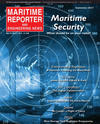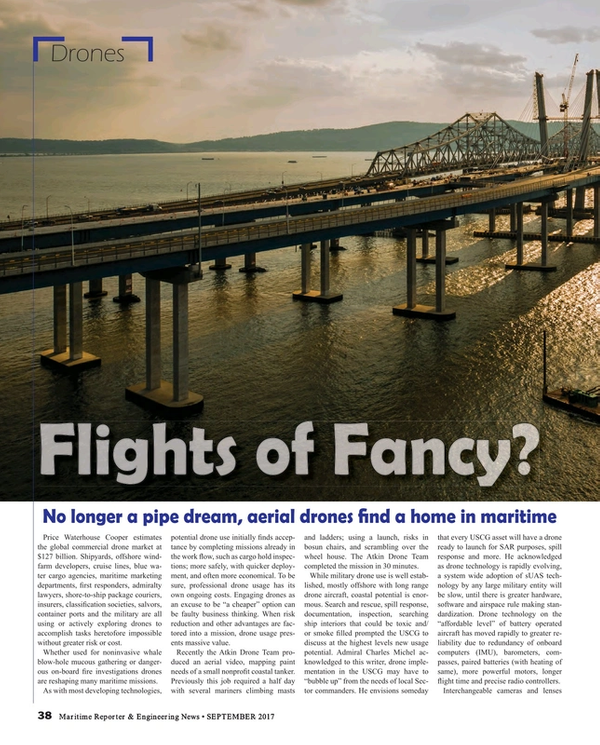
Aerial Drones Take Flight in Maritime
By Jonathan Atkin
Flights of Fancy? No longer a pipe dream, aerial drones find a home in maritime.
Price Waterhouse Cooper estimates the global commercial drone market at $127 billion. Shipyards, offshore wind-farm developers, cruise lines, blue water cargo agencies, maritime marketing departments, first responders, admiralty lawyers, shore-to-ship package couriers, insurers, classification societies, salvors, container ports and the military are all using or actively exploring drones to accomplish tasks heretofore impossible without greater risk or cost.
Whether used for noninvasive whale blow-hole mucous gathering or dangerous on-board fire investigations drones are reshaping many maritime missions.
As with most developing technologies, potential drone use initially finds acceptance by completing missions already in the work flow, such as cargo hold inspections; more safely, with quicker deployment, and often more economical. To be sure, professional drone usage has its own ongoing costs. Engaging drones as an excuse to be “a cheaper” option can be faulty business thinking. When risk reduction and other advantages are factored into a mission, drone usage presents massive value.
Recently the Atkin Drone Team produced an aerial video, mapping paint needs of a small nonprofit coastal tanker. Previously this job required a half day with several mariners climbing masts and ladders; using a launch, risks in bosun chairs, and scrambling over the wheel house. The Atkin Drone Team completed the mission in 30 minutes.
While military drone use is well established, mostly offshore with long range drone aircraft, coastal potential is enormous. Search and rescue, spill response, documentation, inspection, searching ship interiors that could be toxic and/or smoke filled prompted the USCG to discuss at the highest levels new usage potential. Admiral Charles Michel acknowledged to this writer, drone implementation in the USCG may have to “bubble up” from the needs of local Sector commanders. He envisions someday that every USCG asset will have a drone ready to launch for SAR purposes, spill response and more. He acknowledged as drone technology is rapidly evolving, a system wide adoption of sUAS technology by any large military entity will be slow, until there is greater hardware, software and airspace rule making standardization. Drone technology on the “affordable level” of battery operated aircraft has moved rapidly to greater reliability due to redundancy of onboard computers (IMU), barometers, compasses, paired batteries (with heating of same), more powerful motors, longer flight time and precise radio controllers.
Interchangeable cameras and lenses with infrared, FLIR and other payloads make drones a multi-mission platform. Coupled with hardware, innovative software permits vector based search and rescue, mapping, analysis, 3D representations, thermographic imaging and more. Echoing Admiral Michel’s concern, DJI drones now have ADS-B receivers, alerting the operator of nearby manned aircraft. Other systems and protocols for safe integration of airspace will undoubtedly become commonplace.
The largest challenge of maritime users is to apply due diligence to drone use as they do for all other maritime missions. Whether contracting outside agencies or developing in-house drone teams, maritime agencies will no longer assign drone usage ad hoc by calling “Uncle Joe” with an amateur early Phantom to fly haphazardly, snapping photos or rolling the “video tape,” at perhaps some risk to all.
The maritime sector requires vetted drone pilots, camera operators with FAA licenses, liability insurance, thorough experience in the care and feeding of complex drone equipment, batteries, maintenance, record keeping, complete competence in manual flying (with and without amazing telemetry) and expertise with innovative software. Marketing divisions are using drones as great visual solutions, but they must be the right tool for the job. Drones are not a “cheaper” alternative to manned aircraft. They are indeed a unique and different tool for an immersive vantage point. Therefore, drone operators must be more than “techies” but marine savvy professional filmmakers and photographers, fused with a fundamental passion and in-depth knowledge of the marine sector and its unique needs to successfully complete maritime missions.
My Favorite Drone
From a life photographing from hot air balloons, kites, parasails and professionally from manned helicopters, Jonathan Atkin eagerly embraces drones as amazing photo platforms supplementing, not in place of manned helicopters. The Atkin Drone team includes Jeff Brink, an award winning cinematographer, FAA certified Pilot-in-Command, co-founder of Aerobo, a premier cinematography company. And several on call video editors. Our fleet includes six aircraft, and the state-of-the-art DJI Inspire 2, is our “beast.” The X5s camera and lenses are brilliant. Love it. It is unfazed by moderate breeze, with massive telemetry redundancy and sounds really cool. Two other Inspire 1s are in the “Atkin hangar” as well. All Inspires retract landing gear, giving unobstructed views with full 3 axis gimbals. The latest Phantom 4 Pro has build quality that makes you want to feed it as a pet. An early Phantom 3 Pro with mounted flood lights and the small “fly-me-through the wheelhouse,” DJI Mavic Pro. Round out the hangar. My fave? that’s like which child? Inspire2 simply for quality, stability and show stopping awesomeness. The Mavic Pro for unequalled ease of set up, surprising capability, flyability and the grins elicited when its “transformer” character unfolds from a small package.
The Author
Jonathan Atkin, NYC based; known for meticulously planned aerial media from manned helicopters enhances branding for blue water cargo shipping, cruise lines, towing companies, shipyards and the broader workboat sector with passion and knowledge throughout North America. With a fleet of hi-res camera drones, the Atkin Drone Team, (insured and licensed) offers clients options for drone assisted immersive aerial images heretofore unachievable with other photo platforms.
(As published in the September 2017 edition of Maritime Reporter & Engineering News)
Read Aerial Drones Take Flight in Maritime in Pdf, Flash or Html5 edition of September 2017 Maritime Reporter
Other stories from September 2017 issue
Content
- Marine Casualty Investigation page: 10
- The Art of Navigation page: 14
- The Nautical Safety Profile page: 14
- Ocean Guardian: Simplifying Environmental Compliance page: 16
- LNG: Maritime's 'Fuel of the Future' page: 20
- USCG Releases Draft Cyber Guide for Maritime Facilities page: 28
- Data Analytics in the Maritime Space page: 29
- Inside the USS Gerald R. Ford page: 30
- Aerial Drones Take Flight in Maritime page: 38
- FPSOs: New Storage Tank Explosion Frequencies page: 42
- Interferry Mission: Strength from Unity page: 46


